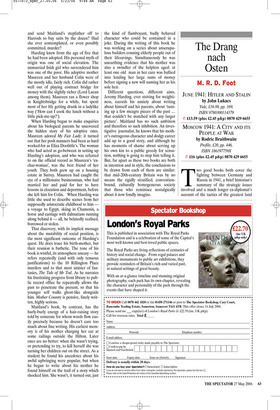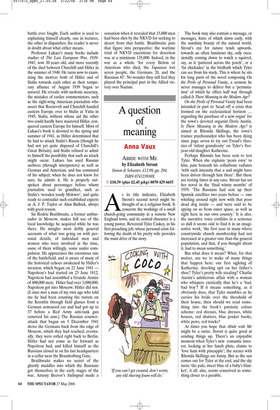The Drang nach Osten
M. R. D. Foot
JUNE 1941: HITLER AND STALIN by John Lukacs Yale, £16.99, pp. 169, ISBN 9780300114379 V £13.59 (plus £2.45 p&p) 0870 429 6655 MOSCOW 1941: A CITY AND ITS PEOPLE AT WAR by Rodric Braithwaite Profile, £20, pp. 446, ISBN 186197759X V £16 (plus £2.45 p&p) 0870 429 6655 Two good books both cover the fighting between Germany and Russia in 1941, a brief historian’s summary of the strategic issues involved and a much longer ex-diplomat’s account of the tactics of the greatest land battle ever fought. Each author is used to explaining himself clearly, one in lectures, the other in dispatches; the reader is never in doubt about what either means.
Professor Lukacs’s many books include studies of The Last European War, 19391941, now 30 years old, and more recently of the duel between Churchill and Hitler in the summer of 1940. He turns now to examining the motives both of Hitler and of Stalin towards each other as their temporary alliance of August 1939 began to unravel. He reveals, with sardonic accuracy, the mistakes of earlier commentators, such as the right-wing American journalists who assert that Roosevelt and Churchill handed eastern Europe over to Stalin at Yalta in 1945; Stalin, without whose aid the other two could hardly have mastered Hitler, conquered eastern Europe for himself. Most of Lukacs’s book is devoted to the spring and summer of 1941, as Hitler determined that he had to attack Stalin’s Russia (though he had not yet quite disposed of Churchill’s Great Britain), and Stalin refused to admit to himself the possibility that such an attack might occur. Lukacs has used Russian archives (through interpreters) as well as German and American, and has command of his subject; when he does not know for sure, he admits it. He is properly outspoken about personages before whom journalists used to genuflect, such as Stalin’s ‘wooden toady Molotov’, and quite ready to contradict such established experts as A. J. P. Taylor or Alan Bullock, always with good reason.
Sir Rodric Braithwaite, a former ambassador in Moscow, makes full use of the local knowledge he acquired while he was there. He mingles most deftly general accounts of what was going on with personal details, of individual men and women who were involved at the time, some of them willingly, some under compulsion. He appreciates the enormous size of the battlefield, and is aware of many of the historical echoes awakened by Hitler’s invasion, which began on 22 June 1941 — Napoleon’s had started on 23 June 1812. Napoleon had assembled a Grande Armée of 600,000 men; Hitler had over 3,000,000. Napoleon got into Moscow; Hitler did not. (I once met a man of my own age who told me he had been counting the turrets on the Kremlin through field glasses from a German armoured car and had got up to 37 before a Red Army anti-tank gun removed his arm.) The Russian counterattack that began on 5 December 1941 drove the Germans back from the edge of Moscow, which they had reached; eventually, they were rolled right back to Berlin. Hitler had not come as far forward as Napoleon had, and killed himself as the Russians closed in on his last headquarters in a cellar near the Brandenburg Gate.
Braithwaite makes no secret of the ghastly muddles into which the Russians got themselves in the early stages of the war. Antony Beevor’s Stalingrad made a sensation when it revealed that 15,000 men had been shot by the NKVD for seeking to desert from that battle. Braithwaite puts that figure into perspective: the wartime total of NKVD executions for desertion was at a minimum 135,000. Indeed, in the war as a whole ‘for every Briton or American who died, the Japanese lost seven people, the Germans 20, and the Russians 85’. No wonder they still feel they played the principal part in the Allied victory over Nazism.











































































































 Previous page
Previous page